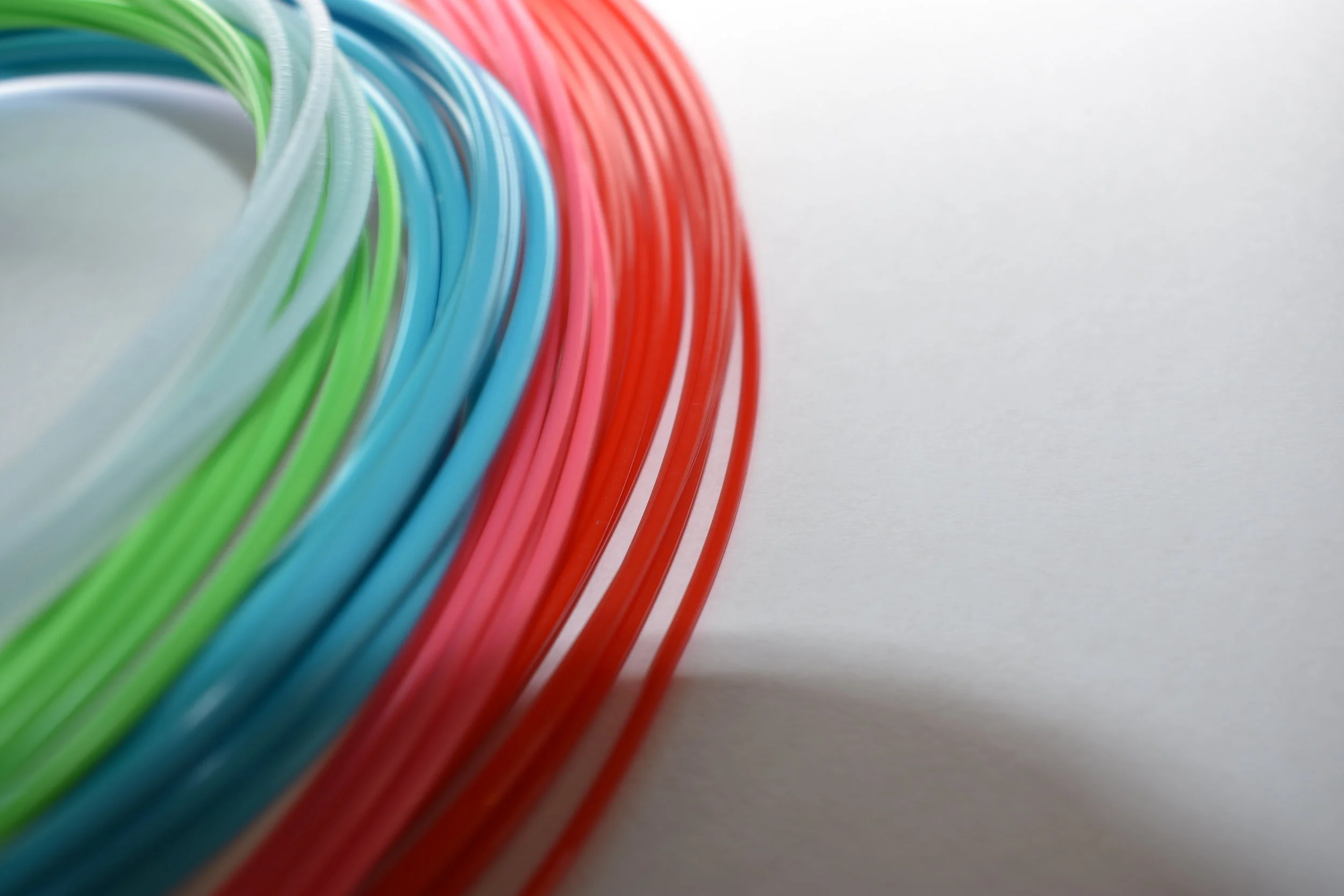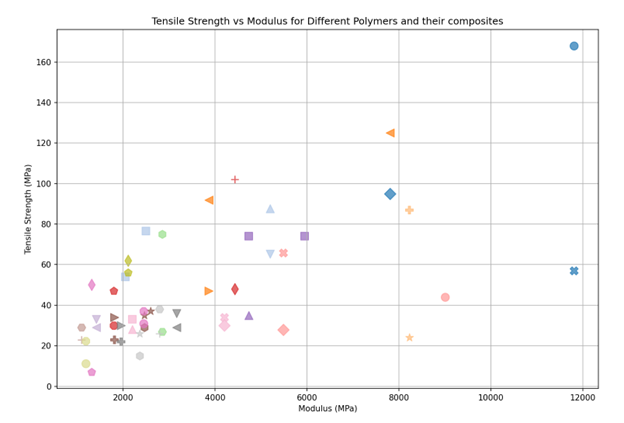Most Common 3D Printing Materials
Outline: Below, we outline some of the most popular materials for 3D printing. Also follow the links for focused pages on various types of material below.
Understanding Different 3D Print Materials:
Filament-Based Materials for Rapid Prototyping
Common base polymers for 3D printing Plastic Material
Composites
High Strength
Flexible Materials
Conductive Materials
Support Materials
Sustainable and Recycled Materials
Resin Materials for DLP Printing
Summary
Plastic 3D Printing Materials:
3D Printing, also known as Additive Manufacturing, deposits layer by layer and uses a variety of materials depending on the printing method and desired outcome. The most widely used 3D Printing technology is Fused Deposition Modeling (FDM), which primarily employs thermoplastic filaments.
In general, PLA is the most common 3d printing material as it is easy to print, relatively inexpensive and works well without a heated bed or enclosure. This is followed by ABS for FDM (Fused Deposition Modeling) printers due to their ease of use and affordability. PLA is biodegradable and easy to print with, while ABS is more durable and heat-resistant. PETG offers a good balance between ease of use and durability. Each material has its properties, strengths, and suitable applications. In production for very low-cost parts injection molding is often used. However, in low quantities, Additive Manufacturing is more cost-effective as high-cost molds are not needed.
Here's an overview of common 3D printer filaments:
-
PLA Filament has become one of the most common materials for 3D printing because it is easy to print, biodegradable, and derived from corn and other biomaterials. It prints at relatively low temperatures (190-220°C) with minimal warping, making it ideal for beginners.
Key Properties:
Print temperature: 190-220°C
Bed temperature: 20-60°C (optional)
Low shrinkage and warping, and minimal odor
Biodegradable under industrial composting conditions
Good surface finish and detail reproduction
Limited heat resistance and durability
Ideal for prototypes, low-wear toys, and decorative items when 3D Printing Plastic Material.
-
Enhanced PLA Variants
An improved formulation of standard PLA that offers significantly better mechanical properties while maintaining the ease of printing.
Improvements over standard PLA:
3-4x higher impact resistance
Improved layer adhesion
Better temperature resistance (up to 70°C vs 50°C for standard PLA)
Less brittle, more durable prints
Similar printing parameters to standard PLA
-
ABS is another common 3D printing filament. ABS offers superior mechanical properties compared to PLA, with better impact resistance and higher temperature tolerance. However, it requires more careful temperature management and produces fumes during printing.
Key Properties:
Print temperature: 220-260°C
Bed temperature: 80-110°C
Higher impact resistance than PLA
Better temperature resistance
Can be acetone-smoothed for glossy finish
Durable and heat-resistant
Suitable for functional parts, automotive components, and electronics housings
-
PETG combines the ease of printing similar to PLA with the mechanical properties closer to ABS. It's chemically resistant and food-safe when properly printed. (Plastic water bottles use this type of plastic)
Key Properties:
Print temperature: 220-250°C
Bed temperature: 70-80°C
Chemical resistance
Food-safe applications
Crystal clear transparency available
Combines ease of use with durability
Good chemical resistance and water-resistant properties
Used for food-safe containers, mechanical parts, and outdoor items
-
Recommended when you need it to have good outside performance exposed to UV (durability and weather resistance).
Key Properties:
Similar to ABS but with better weather resistance
Ideal for outdoor applications and automotive parts
Inherently weather-resistant
Excellent UV stability
Chemical resistance to environmental exposure
Print temperature: 240-260°C
Bed temperature: 90-110°C
No post-processing required for weather resistance
-
Nylon can be sourced with different chain lengths and is desirable for its high strength and high heat resistance.
Properties:
High strength and durability
Good chemical resistance
Self-lubricating properties
Print temperature: 240-280°C
Bed temperature: 80-120°C
Requires dry storage and controlled humidity printing
High strength-to-weight ratio and durability
Good for functional prototypes, tools, and end-use parts
Can be challenging to print due to hygroscopic nature
-
Engineering-grade thermoplastic known for its exceptional impact resistance and transparency.
Properties:
Print temperature is higher temperature: 270-310°C
Bed temperature: 90-120°C
Extremely high strength and impact resistance
Excellent optical clarity
Temperature resistance up to 140°C
Requires enclosed chamber and heated bed
High heat resistance
Used for engineering applications and protective gear
-
Flexible material available in waterproof formulations for seals, gaskets, and other flexible applications. There are different variants with a range of shore hardness. 98A is relatively stiff, but the most easily printed and suitable for multi-material printing with systems such as an AMS (automatic material system) for changing materials/colors in a multi-material multicolor print. There are also compositions that include foaming functionality, where printing at higher temperatures and/or slowly will yield a softer shore hardness, such as TPU AIR.
Key Properties:
Flexible and elastic material
Excellent for creating shock-absorbing components, phone cases, and wearables
Characteristics:
Flexible and elastic
Waterproof when properly printed
Excellent abrasion resistance
Print temperature: 210-250°C
Slow printing speeds required
Shore hardness typically 85A-95A
Thermoplastic Elastomers: This involves many elastomers other than TPU. One example is Ninjaflex.
Composites
-
(Cellulose + PLA) Filament is a high-strength highly robust material made from wood fiber and typically PLA. It has the look, feel, and even the smell of natural wood.
PLA mixed with wood fibers for a wood-like appearance and feel
Suitable for decorative items and prototypes
-
Silky texture
-
PLA with metal powder for a metallic look and feel
Heavier than standard PLA, used for decorative pieces
-
Specifically engineered for applications requiring high toughness and impact resistance.
Properties:
Exceptional impact resistance
Reduced brittleness
Maintains easy printability
Ideal for tools, fixtures, and mechanical parts
-
Professional-grade PLA with enhanced strength and durability characteristics.
Features:
Superior tensile strength
Improved flexibility without sacrificing rigidity
Better UV resistance
Enhanced thermal properties
Suitable for functional prototypes
Carbon Fiber Composite Materials
-
LA reinforced with carbon fiber particles for enhanced strength and stiffness.
Characteristics:
Significantly increased stiffness and strength
Reduced weight compared to solid plastic
Matte, professional finish
Requires hardened steel nozzle due to abrasive nature
Print temperature: 200-230°C
-
ASA (Acrylonitrile Styrene Acrylate) reinforced with carbon fiber for outdoor applications requiring UV resistance.
Benefits:
Exceptional UV resistance
High strength-to-weight ratio
Excellent surface finish
Temperature resistance similar to ABS
Print temperature: 240-270°C
Bed temperature: 90-110°C
Ideal for automotive and outdoor applications
-
The combination of polycarbonate's impact resistance with carbon fiber reinforcement.
Properties:
Exceptional impact resistance
High temperature resistance
Professional appearance
Print temperature: 280-320°C
Bed temperature: 100-130°C
Requires enclosed heated chamber
-
Item description
-
Item description
-
Carbon fiber reinforced PETG offering enhanced properties while maintaining chemical resistance.
Features:
Improved mechanical properties over standard PETG
Chemical resistance maintained
Professional matte finish
Print temperature: 230-260°C
Bed temperature: 70-90°C
-
Better mechanical properties than PETG
As can been seen on the figure above, PAHT-CF and PPA-CF have very impressive tensile strength and moduli. PET-CF is stronger than PETG-CF
Common materials used in injection molding
-
Chemical-resistant thermoplastic with excellent water resistance and flexibility.
Properties:
Completely waterproof
Excellent chemical resistance
High fatigue resistance
Very low density (floats on water)
Print temperature: 220-250°C
Bed temperature: 90-110°C (with adhesion aids)
Challenging to print due to poor bed adhesion
-
DescriChemical-resistant plastic commonly used in containers and marine applications.
Features:
Completely waterproof
Excellent chemical resistance
Food-safe applications
Very challenging to print (poor adhesion)
Print temperature: 220-260°C
Requires specialized bed preparationption text goes here
3D Print Materials aren’t all in filament form. There are many Resins used for SLA (Stereolithography) and DLP (Digital Light Processing) printers with a wide range of material properties
Resin (for SLA/DLP printers):
Provides high detail and smooth surface finish
Various formulations for different properties (tough, flexible, castable)
Metal powders (for SLS/DMLS printers):
Used for creating functional metal parts
Materials include aluminum, titanium, stainless steel, and more
Ceramic powders:
For specialized applications in industries like aerospace and medical
Each material has its unique properties, strengths, and weaknesses, making them suitable for different applications. The choice of material depends on the specific requirements of the project, such as mechanical properties, environmental resistance, biocompatibility, and post-processing needs.
Material Selection Summary
For Beginners:
Start with PLA or PLA+
Consider PETG for more demanding applications
Avoid high-temperature materials until experienced
For Functional Parts:
ABS or ASA for temperature resistance
Nylon for wear resistance
PETG for chemical resistance
Carbon fiber composites for strength
For Outdoor Applications:
ASA for UV resistance
PP for marine environments
Carbon fiber ASA for structural outdoor parts
For Professional/Industrial Use:
PEEK for ultimate performance
PEI for aerospace applications
PPSU for medical devices
PC for impact-critical applications
Printing Considerations
Nozzle Requirements:
Standard brass nozzles: PLA, PETG, ABS, ASA
Hardened steel nozzles: Carbon fiber materials, abrasive filaments
Ruby or sapphire nozzles: Extreme abrasive materials
Printer Requirements:
Entry-level printers: PLA, PLA variants
Mid-range enclosed printers: ABS, ASA, PETG, Nylon
High-temperature printers: PC, PEI, PEEK
Industrial printers: All materials with proper setup
Storage Requirements:
Hygroscopic materials (Nylon, PVA, PETG): Dry storage essential
Standard materials (PLA, ABS): Cool, dry storage recommended
High-performance materials: Vacuum storage often required



